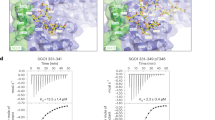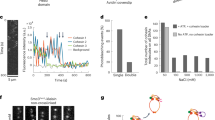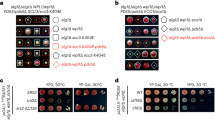Abstract
The multisubunit protein complex cohesin is required to establish cohesion between sister chromatids during S phase and to maintain it during G2 and M phases. Cohesin is essential for mitosis, and even partial defects cause very high rates of chromosome loss. In budding yeast, cohesin associates with specific sites which are distributed along the entire length of a chromosome but are more dense in the vicinity of the centromere. Real-time imaging of individual centromeres tagged with green fluorescent protein suggests that cohesin bound to centromeres is important for bipolar attachment to microtubules. This cohesin is, however, incapable of resisting the consequent force, which leads to sister centromere splitting and chromosome stretching. Meanwhile, cohesin bound to sequences flanking the centromeres prevents sister chromatids from completely unzipping and is required to pull back together sister centromeres that have already split. Cohesin therefore has a central role in generating a dynamic tension between microtubules and sister chromatid cohesion at centromeres, which lasts until chromosome segregation is finally promoted by separin-dependent cleavage of the cohesin subunit Scc1p.
This is a preview of subscription content, access via your institution
Access options
Subscribe to this journal
Receive 12 print issues and online access
$209.00 per year
only $17.42 per issue
Buy this article
- Purchase on Springer Link
- Instant access to full article PDF
Prices may be subject to local taxes which are calculated during checkout






Similar content being viewed by others
References
Bickel, S. E. & Orr-Weaver, T. L. Holding chromatids together to ensure they go their separate ways. BioEssays 18, 293–300 (1996).
Miyazaki, W. Y. & Orr-Weaver, T. L. Sister-chromatid cohesion in mitosis and meiosis. Annu. Rev. Genet. 28, 167–187 (1994).
Nasmyth, K. Separating sister chromatids. Trends Biochem. Sci. 24, 98–104 (1999).
Guacci, V., Koshland, D. & Strunnikov, A. A direct link between sister chromatid cohesion and chromosome condensation revealed through the analysis of MCD1 in S. cerevisiae. Cell 91, 47–57 (1997).
Michaelis, C., Ciosk, R. & Nasmyth, K. Cohesins: chromosomal proteins that prevent premature separation of sister chromatids. Cell 91, 35–45 (1997).
Toth, A. et al. Yeast cohesin complex requires a conserved protein, Eco1p (Ctf7), to establish cohesion between sister chromatids during DNA replication. Genes Dev. 13, 320–333 (1999).
Losada, A., Hirano, M. & Hirano, T. Identification of Xenopus SMC protein complexes required for sister chromatid cohesion. Genes Dev. 12, 1986–1997 (1998).
Uhlmann, F. & Nasmyth, K. Cohesion between sister chromatids must be established during DNA replication. Curr. Biol. 8, 1095–1101 (1998).
Skibbens, R. V., Corson, L. B., Koshland, D. & Hieter, P. Ctf7p is essential for sister chromatid cohesion and links mitotic chromosome structure to the DNA replication machinery. Genes Dev. 13, 307–319 (1999).
Tanaka, K. et al. Fission yeast Eso1p is required for establishing sister chromatid cohesion during S phase. Mol. Cell. Biol. 20, 3459–3469 (2000).
Ciosk, R. et al. Cohesin’s binding to chromosomes depends on a separate complex consisting of Scc2 and Scc4 proteins. Mol. Cell 5, 243–254 (2000).
Furuya, K., Takahashi, K. & Yanagida, M. Faithful anaphase is ensured by Mis 4, a sister chromatid cohesion molecule required in S phase and not destroyed in G1 phase. Genes Dev. 12, 3408–3418 (1998).
Uhlmann, F., Lottspeich, F. & Nasmyth, K. Sister chromatid separation at anaphase onset promoted by cleavage of the cohesin subunit Scc1p. Nature 400, 37–42 (1999).
Nasmyth, K., Peters, J-M. & Uhlmann, F. Splitting the chromosome: cutting the ties that bind sister chromatids. Science 288, 1379–1384 (2000).
Ciosk, R. et al. An ESP1/PDS1 complex regulates loss of sister chromatid cohesion at the metaphase to anaphase transition in yeast. Cell 93, 1067–1076 (1998).
Kumada, K. et al. Cut1 is loaded onto the spindle by binding to Cut2 and promotes anaphase spindle movement upon Cut2 proteolysis. Curr. Biol. 8, 633–641 (1998).
Cohen-Fix, O., Peters, J. M., Kirschner, M. W. & Koshland, D. Anaphase initiation in Saccharomyces cerevisiae is controlled by the APC-dependent degradation of the anaphase inhibitor Pds1p. Genes Dev. 10, 3081–3093 (1996).
Funabiki, H. et al. Cut2 proteolysis required for sister-chromatid seperation in fission yeast. Nature 381, 438–441 (1996).
Kim, S. H., Lin, D. P., Matsumoto, S., Kitazono, A. & Matsumoto, T. Fission yeast slp1: An effector of Mad2-dependent spindle checkpoint. Science 279, 1045–1047 (1998).
Hwang, L. H. et al. Budding yeast Cdc20: a target of the spindle checkpoint. Science 279, 1041–1044 (1998).
Lim, H. H., Goh, P. Y. & Surana, U. Cdc20 is essential for the cyclosome-mediated proteolysis of both Pds1 and Clb2 during M phase in budding yeast. Curr. Biol. 8, 231–234 (1998).
Fang, G., Yu, H. & Kirschner, M. W. The checkpoint protein MAD2 and the mitotic regulator CDC20 form a ternary complex with the anaphase-promoting complex to control anaphase initiation. Genes Dev. 12, 1871–1883 (1998).
Shirayama, M., Zachariae, W., Ciosk, R. & Nasmyth, K. The Polo-like kinase Cdc5p and the WD-repeat protein Cdc20p/Fizzy are regulators and substrates of the anaphase promoting complex in Saccharomyces cerevisiae. EMBO J. 17, 1336–1349 (1998).
Zachariae, W. & Nasmyth, K. Whose end is destruction: cell division and the anaphase-promoting complex. Genes Dev. 13, 2039–2058 (1999).
Visintin, R., Prinz, S. & Amon, A. CDC20 and CDH1: a family of substrate-specific activators of APC-dependent proteolysis. Science 278, 460–463 (1997).
Tanaka, T., Cosma, M. P., Wirth, K. & Nasmyth, K. Identification of cohesin association sites at centromeres and along chromosome arms. Cell 98, 847–858 (1999).
Megee, P. C., Mistrot, C., Guacci, V. & Koshland, D. The centromeric sister chromatid cohesion site directs Mcd1p binding to adjacent sequences. Mol. Cell 4, 445–450 (1999).
Blat, Y. & Kleckner, N. Cohesins bind to preferential sites along yeast chromosome III, with differential regulation along arms versus the centric region. Cell 98, 249–259 (1999).
Goshima, G. & Yanagida, M. Establishing biorientation occurs with precocious separation of sister kinetochores, but not the arms, in the early spindle of budding yeast. Cell 100, 619–633 (2000).
Guacci, V., Hogan, E. & Koshland, D. Chromosome condensation and sister chromatid pairing in budding yeast. J. Cell Biol. 125, 517–530 (1994).
Knop, M. et al. Epitope tagging of yeast genes using a PCR-based strategy: more tags and improved practical routines. Yeast 15, 963–972 (1999).
Goh, P. Y. & Kilmartin, J. V. NDC 10: a gene involved in chromosome segregation in Saccharomyces cerevisiae. J. Cell Biol. 121, 503–512 (1993).
Hyman, A. A. & Sorger, P. K. Structure and function of kinetochores in budding yeast. Annu. Rev. Cell Dev. Biol. 11, 471–495 (1995).
Baum, P., Yip, C., Goetsch, L. & Byers, B. A yeast gene essential for regulation of spindle pole duplication. Mol. Cell Biol. 8, 5386–5397 (1988).
Inoue, S. & Salmon, E. D. Force generation by microtubule assembly/disassembly in mitosis and related movements. Mol. Biol. Cell 6, 1619–1640 (1995).
Skibbens, R. V., Skeen, V. P. & Salmon, E. D. Directional instability of kinetochore motility during chromosome congression and segregation in mitotic newt lung cells: a push-pull mechanism. J. Cell Biol. 80, 674–691 (1993).
Nicklas, R. B. How cells get the right chromosomes. Science 275, 632–637 (1997).
Waters, J. C., Skibbens, R. V. & Salmon, E. D. Oscillating mitotic newt lung cell kinetochores are, on average, under tension and rarely push. J. Cell Sci. 109, 2823–2831 (1996).
Straight, A. F., Belmont, A. S., Robinett, C. C. & Murray, A. W. GFP tagging of budding yeast chromosomes reveals that protein-protein interactions can mediate sister chromatid cohesion. Curr. Biol. 6, 1599–1608 (1996).
Straight, A. F., Marshall, W. F., Sedat, J. W. & Murray, A. W. Mitosis in living budding yeast: anaphase A but no metaphase plate. Science 277, 574–578 (1997).
Scherthan, H., Loidl, J., Schuster, T. & Schweizer, D. Meiotic chromosome condensation and pairing in Saccharomyces cerevisiae studied by chromosome painting. Chromosoma 101, 590–595 (1992).
He, X., Asthana, S. & Sorger, P. K. Transient sister chromatid separation and elastic deformation of chromosomes during mitosis in budding yeast. Cell 101, 763–775 (2000).
Nabeshima, K. et al. Dynamics of centromeres during metaphase-anaphase transition in fission yeast: Dis1 is implicated in force balance in metaphase bipolar spindle. Mol. Biol. Cell 9, 3211–3225 (1998).
Winey, M. et al. Three-dimensional ultrastructural analysis of the Saccharomyces cerevisiae mitotic spindle. J. Cell Biol. 129, 1601-1615 (1995).
Hirano, T. SMC-mediated chromosome mechanics: a conserved scheme from bacteria to vertebrates? Genes Dev. 13, 11–19 (1999).
Rieder, C. L. & Cole, R. Chromatid cohesion during mitosis: lessons from meiosis. J. Cell Sci. 112, 2607–2613 (1999).
Pidoux, A. L. & Allshire, R. B. Centromeres: getting a grip of chromosome. Curr. Opin. Cell Biol. 12, 308–319 (2000).
Jin, Q.-w., Fuchs, J. & Loidl, J. Centromere clustering is a major determinant of yeast interphase nuclear organization. J. Cell Sci. 113, 1903–1912 (2000).
Thierry, A., Gaillon, L., Galibert, F. & Dujon, B. Construction of a complete genomic library of Saccharomyces cerevisiae and physical mapping of chromosome XI at 3.7 kb resolution. Yeast 11, 121–135 (1995).
Loidl, J., Klein, F. & Engebrecht, J. in Nuclear Structure and Function (ed. Berrios, M.) 257–285 (Academic Press, San Diego, 1998).
Acknowledgements
We especially thank K. Paiha, P. Steinlein, A. Desai and T. Hyman for helping to set up the time-lapse system. We also thank Q.-w. Jin, F. Severin, T. Hyman, M. Glotzer and people in the Nasmyth laboratory for encouraging discussions; R. Ciosk, F. Uhlmann and E. Schiebel for yeast strains and plasmids; G. Goshima, M. Yanagida, X. He and P. Sorger for communicating unpublished results; M. Glotzer, F. Uhlmann and V. Katis for their critical comments on the manuscript; and M. Galova, H. Tkadletz and J. Erdei for their technical help. This work was supported by grants from the Austrian Industrial Research Promotion Fund (FFF no. 802746), Austrian Science Fund (FWF no. 8202) and Human Frontiers Science Program Organization.
Correspondence and requests for materials should be addressed to K.N. Supplementary Information is available on Nature Cell Biology’s World-Wide Web site (http://www.nature.com/ncb)
Author information
Authors and Affiliations
Corresponding author
Supplementary information
Movie1
Sister centromeres split and reassociate repeatedly before moving finally to opposite spindle poles (Fig. 3b). (MOV 2145 kb)
Movie 2
Sister centromeres do not separate in an ndc 10-1 mutant at 37°C (Fig. 3c). (MOV 530 kb)
Movie 3
Sister centromeres split upon SPB duplication and do not reasso-ciate in the absence of Scc 1p (Fig. 4b). A cell of GAL-SCC 1, scc 1D strain. To deplete Scc 1p in the cells, they were grown in YEP-RaffGal, filtrated and cultured in YEP-Glc for 2 h before the time-lapse observation. (MOV 994 kb)
Movie 4
Sister centromeres split infrequently, and then only transiently, 4 soon after SPB duplication in the presence of Scc 1p (Fig. 4c; control of Movie 3 (Fig. 4b)). (MOV 1709 kb)
Movie 5
Both sister centromeres are frequently found moving in the vicin-ity of a single SPB in the absence of Scc 1p (Fig. 5a). A cell of GAL-SCC 1, scc 1D strain. Scc 1p was depleted as in Movie 3. (MOV 1338 kb)
The yeast cells shown in Fig.3b, c, 4b, c and 5a are displayed in movies 1-5. GFP and Nomarski images are presented. Both a locus at 1.4 kb from CEN 5 and spindle pole bodies (SPBs) were visualized as GFP dots. The speed of movies are 100 times faster than the real speed at which the events happen. All cells shown here harbour tetR-GFP, tetOs at 1.4 kb from CEN 5, SPC 42-GFP.
Rights and permissions
About this article
Cite this article
Tanaka, T., Fuchs, J., Loidl, J. et al. Cohesin ensures bipolar attachment of microtubules to sister centromeres and resists their precocious separation. Nat Cell Biol 2, 492–499 (2000). https://doi.org/10.1038/35019529
Received:
Revised:
Accepted:
Published:
Issue Date:
DOI: https://doi.org/10.1038/35019529
This article is cited by
-
CCAR2 controls mitotic progression through spatiotemporal regulation of Aurora B
Cell Death & Disease (2022)
-
Differential abundance and transcription of 14-3-3 proteins during vegetative growth and sexual reproduction in budding yeast
Scientific Reports (2018)
-
The chromatin remodeler RSF1 controls centromeric histone modifications to coordinate chromosome segregation
Nature Communications (2018)
-
Catching DNA with hoops—biophysical approaches to clarify the mechanism of SMC proteins
Nature Structural & Molecular Biology (2017)
-
Structure of centromere chromatin: from nucleosome to chromosomal architecture
Chromosoma (2017)



